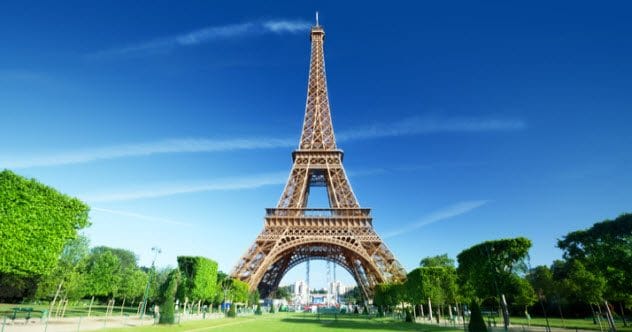Have you ever looked at a famous building and wondered if it could have been different? We recognize landmarks like the Eiffel Tower or the Statue of Liberty instantly. But what if their designers had chosen a completely different path? Get ready to journey into an alternate reality where familiar sights are wonderfully strange. Let’s explore ten iconic structures that were almost something else entirely!
10. The White House
Imagine the White House, but not quite as you know it! Back in 1792, a big competition was held to design the future home for the U.S. President. Many ideas poured in, from classic styles to newer ones. In the end, Irish architect James Hoban’s design, inspired by Leinster House in Dublin, was chosen.
But what if things had gone differently? One of the other ideas came from Thomas Jefferson, who later became the third president. He loved grand European architecture. His plan for the White House included a porch with tall columns and a large dome. Even though his full design wasn’t picked, Jefferson did add his own touches, like colonnades, when he eventually lived there.
9. The Arc de Triomphe
Picture Paris, but instead of the famous Arc de Triomphe, imagine a giant elephant statue! It sounds wild, but this was a real proposal. The current arch, a symbol of Paris, was ordered by Napoleon Bonaparte after a big victory in 1805. It’s based on the Arch of Titus in Rome.
However, about 45 years earlier, an architect named Charles Ribart suggested something truly unique for the same spot. He designed a huge, three-story elephant building. Inside, it would have rooms for parties and balls, reached by a spiral staircase. The elephant’s trunk would even have a drainage system to water a garden outside! French officials didn’t go for this quirky idea, though.
8. Chicago Tribune Tower
Newspaper boss Robert McCormick wanted his Chicago Tribune headquarters to be “the most beautiful office building in the world.” So, in 1923, he held a design competition. Architects from 23 countries sent in 260 ideas!
The winning design, by John Howells and Raymond Hood, gave us the Gothic skyscraper we see today. But not everyone loved it at first. In fact, many people preferred the second-place design by Finnish architect Eliel Saarinen. His idea was a modern, sleek tower that tapered towards the top. Though it didn’t win, Saarinen’s design was seen as a bold step into the future of American architecture and inspired many other buildings.
7. Sydney Opera House
When you think of Sydney, Australia, the beautiful shells of the Opera House probably come to mind. Jorn Utzon’s amazing design was picked from over 200 entries. But what if the runner-up had won? Sydney might have a landmark that looked like a mix between a submarine and a giant seashell!
This alternate design came from a group of seven architects. Like Utzon, they were inspired by the nearby sea. They imagined a spiral, nautilus-like building. It was praised for being strong and fitting for its seaside spot. The design featured large windows and a copper-covered roof made of folded concrete, using the latest building techniques.
6. Statue of Liberty
The Statue of Liberty is a powerful symbol in New York Harbor. But did you know her story almost began very differently, and in a different country? Sculptor Frederic Bartholdi’s first idea was for a statue to stand at the Suez Canal in Egypt.
His original vision was an 86-foot tall statue of an Egyptian peasant woman, a fellaha, holding a torch. This statue, called “Egypt Bringing Light to Asia,” would represent Egypt’s progress and also serve as a lighthouse. However, Egyptian officials couldn’t afford the project. So, Bartholdi changed his design to the Roman goddess Libertas and sent her to New York City, becoming “Liberty Enlightening the World.”
5. Eiffel Tower
Here’s a fun fact: Gustav Eiffel didn’t actually design the Eiffel Tower all by himself! He owned a company that specialized in steel structures. Two of his engineers, Emile Nouguier and Maurice Koechlin, came up with the first plans for the iconic curving tower for the 1889 Paris Exposition. The company’s architect, Stephen Sauvestre, then added decorative touches.
One of Sauvestre’s later ideas, after the tower was already built and popular, was to add two smaller towers on each side of the main one. This would have created a three-part structure instead of the single tower we know. The extra towers were meant to help manage the long lines of visitors. Would this have made it more beautiful or just a steel giant? It’s interesting to think about!
4. Lincoln Memorial
Could you imagine a pyramid in Washington, D.C., honoring Abraham Lincoln? The Washington Monument is an obelisk, inspired by ancient Egypt, so why not a pyramid too? This was a real possibility! In 1912, architect John Russel Pope submitted designs for the Lincoln Memorial that included an Egyptian-style pyramid. He even proposed a ziggurat, like those from ancient Mesopotamia.
Pope was a well-known architect eager to design the memorial. However, the commission chose Henry Bacon’s Greco-Roman temple design instead. While Pope’s pyramid and ziggurat ideas weren’t built, they still capture the imagination of people wondering what might have been.
3. Washington Monument
Plans to honor America’s first president, George Washington, started early. In 1836, architect Robert Mills won the job of designing the memorial. His original vision was much more elaborate than what we see today. It included the famous obelisk, but also a circular, colonnaded building at its base, featuring an equestrian statue of Washington.
However, construction hit a snag in 1856 due to protests and lack of funds. The monument stood unfinished for twenty years. When work finally resumed, Mills’s original grand design was simplified. The colonnade and statue were removed, leaving only the tall, bare obelisk. It’s quite different from what Mills first imagined!
2. Tower Bridge
Tower Bridge is an unmistakable symbol of London, often confused with London Bridge (which is actually further up the river). Sir Horace Jones designed it to solve a tricky problem: how to build a bridge across the Thames for cars and people without blocking riverboats. His solution, completed in 1894, was the famous drawbridge with Victorian Gothic towers.
But there were other ideas. One very futuristic design was from F.J. Palmer. His plan involved roadways on either side of the bridge that would loop. As one side of the loop slid open for a boat, the other would stay closed for traffic. Once the boat passed through part of the loop, that section would close, and another would open. It was complicated, but it aimed to keep both road and river traffic moving smoothly. Ultimately, this complex idea was not chosen.
1. Reichstag
When Germany unified in 1871, they needed a larger building for their parliament. A design competition for the new Reichstag building was held. Among the entrants was British architect Sir Gilbert Scott. Although he didn’t win first prize, his design was highly praised and awarded second place.
Scott’s design featured a grand central dome, 75 feet across, similar to the one on St. Paul’s Cathedral in London. Wings would extend out from this dome in four directions. Scott believed a dome was essential for a building of such importance, no matter the architectural style. Even though his design wasn’t built, he was proud to have competed so well against German architects.
Wow, what a journey through architectural ‘what ifs’! It’s fascinating to see how these world-famous landmarks could have looked so different. From elephantine arches to pyramidal memorials, these unbuilt designs remind us that history is full of choices. Each decision shaped the iconic skylines we know and love today. Who knows what other amazing designs are hidden in the archives?
Which of these alternate designs surprised you the most? Do you prefer any of the original concepts to what was built? Leave your comment below!










